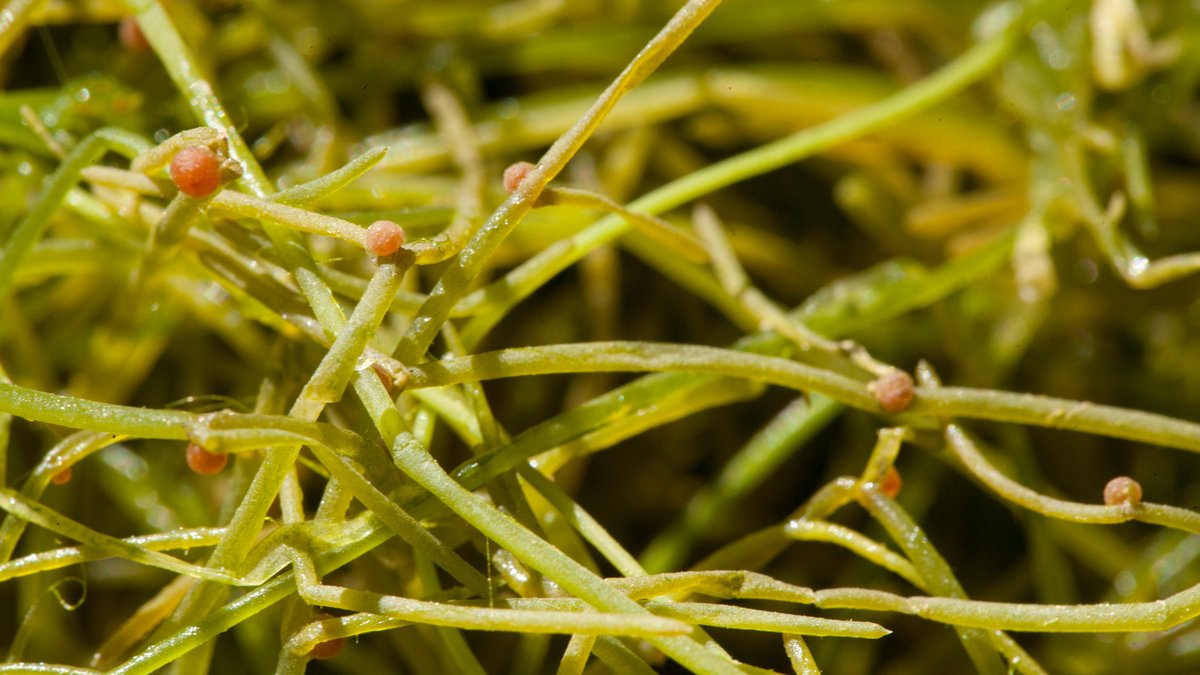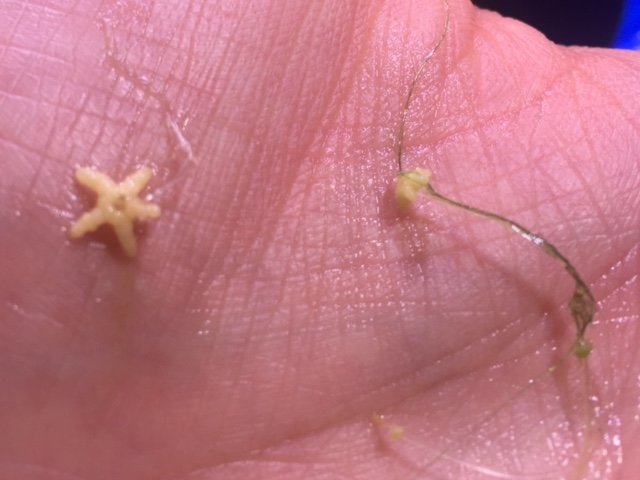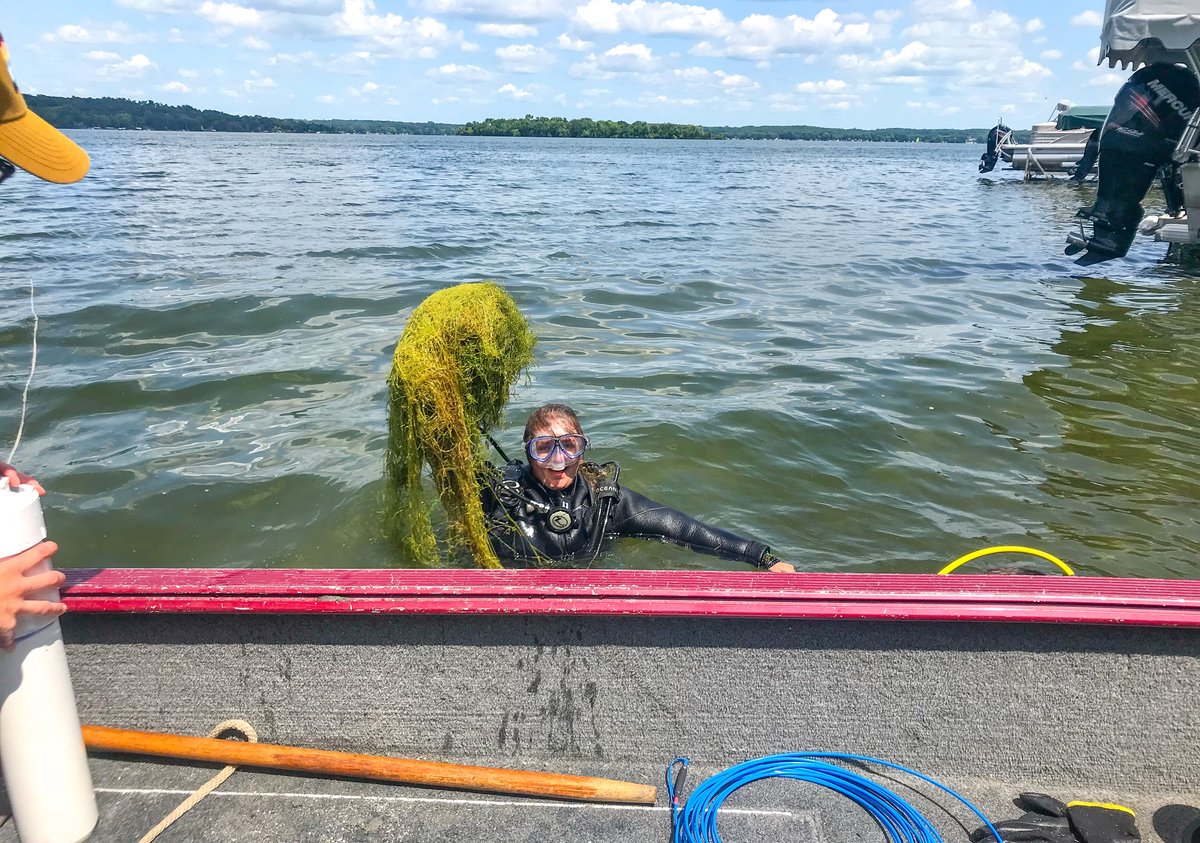Nitellopsis obtusa
Starry stonewort grows in tall and dense colonies. It is known to form mats on the surface of the water that can interfere with recreation and potentially displace native plant species. When it was first found in Minnesota in 2015, MAISRC researchers had to act quickly to learn the basics of invasive alga. More about starry stonewort.
MAISRC findings
- Mechanical and algaecide treatments greatly reduced starry stonewort biomass, but that their star-shaped bulbils, which can regenerate into new plants, remained viable after treatment. This reinforces the importance of a multi-pronged approach to starry stonewort control
- After analyzing 11 years of starry stonewort treatment data across three states, MAISRC researchers have found that current methods (generally copper-based algaecide treatments) are not slowing starry stonewort’s expansion within infested lakes. However, treatments can be effective at reducing abundance, e.g., biomass, of starry stonewort in localized areas, providing nuisance relief. Researchers also found that if infestations are found early enough—when they are still small—sustained hand removal efforts can be highly effective for reducing and containing infestations. These findings emphasize the need for early detection/containment efforts and identify a pressing need for continued research into effective control options for established infestations.
- Completed a predictive risk model for zebra mussels and starry stonewort to inform decision-making and prioritize prevention activities for all Minnesota lakes
- Used location and environmental data to predict which lakes and types of lakes in Minnesota are most vulnerable to invasion
- In June 2016, MAISRC brought together a group of international experts to synthesize what is currently known about the ecology, impacts, and management of starry stonewort and identify key gaps in the science needed to better support management
Research
Managing Midwest aquatic invasives in a changing climate
This research will provide information on the ecology of starry stonewort, a summary of current stakeholder preferences around starry stonewort management, as well as an evaluation of optimal management strategies.
Led by Dr. Ranjan Muthukrishnan
Meta-analysis of treatment outcomes to advance starry stonewort management in Minnesota
This project will improve starry stonewort management by systematically evaluating efficacy of past starry stonewort treatments and translating findings into a readily usable form.
Led by Dr. Daniel Larkin
Risk assessment, control, and restoration research on aquatic invasive plant species
This research aims to create biologically and economically sound solutions to prevent and control invasive plants and to disseminate scientific information that assists the DNR, watershed districts, lake associations, and citizen groups around the state with management strategies.
Led by Dr. Daniel Larkin
Public values of aquatic invasive species management
This project looks to to quantify and analyze the ecological and economic value of AIS damages and AIS management as they relate to ecosystem services such as fishing, swimming, biodiversity, and navigability.
Led by Dr. Amit Pradhananga
Characterizing starry stonewort phenology, growth conditions, and impacts to guide management
This project looks to address the impacts of starry stonewort on native plant communities, the environmental conditions associated with nuisance growth of starry stonewort, and the seasonal growth patterns of starry stonewort in Minnesota.
Led by Dr. Daniel Larkin
Decision-making tool for optimal management of AIS
This project developed a decision-making tool to help AIS managers, counties, and other agencies prioritize their resources for optimal prevention and intervention of AIS, specifically zebra mussels and starry stonewort.
Led by Dr. Nicholas Phelps
Eco-epidemiological model to assess aquatic invasive species management
MAISRC researchers worked to develop a first-of-its-kind eco-epidemiological model that forecasts the potential risk of spread of zebra mussels and starry stonewort across Minnesota.
Led by Dr. Nicholas Phelps
About starry stonewort
Description
The scientific name for starry stonewort is Nitellopsis obtusa. It is a type of freshwater green algae known as a charophyte, a group that also includes muskgrasses and stoneworts (Chara and Nitella species) that are native to Minnesota. Starry stonewort is native to parts of Europe and Asia. It is relatively uncommon in much of its native range and is considered endangered in Japan and of conservation concern in Britain. Starry stonewort can look quite similar to some native charophytes, but may appear larger and more robust. It is a green macroalga with whorls of long, narrow branchlets in groups of 4 to 6 coming off of main shoots. Orange reproductive structures (male antheridia) occur at branchlet nodes. Small, white, star-shaped bulbils are a distinguishing feature that gives it the name starry stonewort.
Life cycle
Starry stonewort is dioecious, meaning that individuals are either male or female — unlike many plants and algae that have both male and female reproductive parts. Interestingly, the best evidence to date indicates that the populations in the U.S. are all male, though there may be undiscovered females. This means that spread of starry stonewort is probably through human movement of fragments from lake to lake. In particular, starry stonewort produces small, star-shaped structures called “bulbils” that allow it to reproduce vegetatively (clonally).
Impacts
Where starry stonewort grows densely and forms surface mats, it can interfere with boating and other recreational activities. Dense growth may also displace native plants and could potentially have impacts on fish and other animals. Starry stonewort’s ecological impacts are not well understood, and there has been little published research to date.
Distribution
Starry stonewort was first found in North America in 1978 in the St. Lawrence River and has spread inland since. It is now found in much of Michigan’s Lower Peninsula and many locations in New York State. It has also been found in Indiana and was discovered in southeastern Wisconsin in 2014. It was first recorded in Minnesota in 2015 (Lake Koronis, Stearns Co.).
How it spreads
Starry stonewort appears to be spreading vegetatively in the U.S. (by bulbils and fragments). Accidental movement by people is the most likely means of dispersal. Many of the known infestations occur in high-use waterbodies and near boat accesses.



